Which Gold is Best for You?
10k, 14k, 18k, and 24k Gold Karat Compared
- Home /
- Diamond Buying Guides /
- 10k, 14k, 18k, and 24k Gold Karat Compared
If you’re looking for an engagement ring or another piece of gold-based jewelry, you should know that the type of gold you select can have a massive impact on its appearance, its feeling, and even its durability. In the engagement ring world, the type of diamond you choose (and how it’s set) should be your main focus - but gold is a close second.
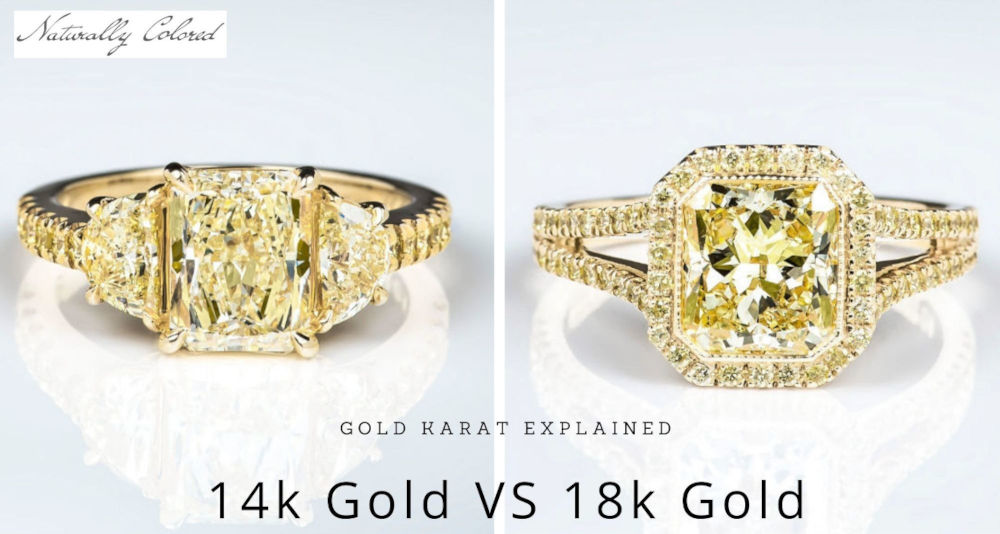 Can you tell the gold karat that is used in these rings?
Can you tell the gold karat that is used in these rings?
But what is a gold karat, exactly? And how should you decide between the different gold purity levels? What are the pros and cons in each karat grade?
- Karat VS Carat
- Is 24K Gold the Best?
- 18K Gold Breakdown
- 14K Gold Breakdown
- 10K Gold Breakdown
- 1K Gold Breakdown
- Gold Colors
- How to Choose?
Gold Karats in a Nutshell
Let’s start with a basic explanation of what a “karat” is and why it’s an important determining factor when choosing a piece of jewelry.
A karat is a measure of the fineness, or purity, of gold. To be specific, a gold karat is approximately 4.1667 percent of a pure gold alloy - in other words, 1/24 of pure gold. A piece with 24-karat gold, therefore, contains gold that is totally pure.
So what about golds that are rated at 18k, 14k, and 10k?
10K vs 14K vs 18K and 24K Gold
These measurements indicate that the material contains 18/24, 14/24, and 10/24 parts gold, respectively. How pure is the gold that is used in your gold engagement ring (or any other piece of jewelry for that matter):
Gold Karat Scale - Gold Purity Chart
| Gold Karats | Gold Purity % | Millesimal Fineness |
|---|---|---|
| 24K | 99.9% | 999 |
| 22K | 91.6% | 916 |
| 20K | 83.33% | 834 |
| 18K | 75% | 750 |
| 14K | 58.33% | 583.3 |
| 12K | 50% | 500 |
| 10K | 41.67% | 417 |
But what are the other parts?
The remaining material is an alloying metal of some sort. A secondary metal is often included not to dilute the purity of gold intentionally, but rather to make the overall substance harder.
This system emerged in the Medieval era with a coin known as a mark. Marks were weighed in terms of carats (a system of weight still used to weigh gems). A full, pure mark was 24 carats/karats – pure gold. But pure marks were nearly impossible to produce because gold is too soft a substance. Harder metals like copper had to be added to produce a more durable alloy; marks were then evaluated based on what percentage of their core material was made of gold.
Karat vs. Carat
Note that karats, a system for measuring the purity of gold, are different than carats, which are commonly used to measure the weight of a diamond. Not only are they used to evaluate different jewelry elements (gold vs. diamonds), but they measure entirely different things. The karat rating of a gold item tells you nothing about the weight, and the carat size of a diamond tells you nothing about its purity.
On top of the above, while carat is used to price diamonds, karat, while does have an affect on pricing, is not part of gold's pricing system.
Is 24k Gold the Best?
After understanding the karat system, you’ll understand that 24 karat gold is “pure” gold. Initially, you may believe this means 24k gold is the best possible option. After all, purity seems to be a good thing - not only will the piece be more attractive and more sought-after, but it will also carry bragging rights, correct?
Not necessarily. While it is the highest karat gold possible and while gold is a beautiful substance, it comes with a lot of disadvantages.
For starters, gold is soft. Despite being dense, and therefore considered a “heavy metal,” gold is remarkably malleable and easy to work with. This makes it an ideal material for jewelry in some respects, because it can be fashioned into any shape easily, but it can also result in weakness. Wearing 24k gold jewelry can leave it vulnerable to scratching, bending, warping, and other forms of damage. For a piece of jewelry to be practical, it needs to be able to retain its shape and remain attractive for a long period of time.
Malleability and softness are just the beginning. Pure gold is also very bright. If you picture “pure gold” in your head, you’re probably thinking of a gold alloy. The true color of pure gold is both brighter and more orange than what most people picture. Accordingly, it makes for unattractive jewelry in many cases.
On top of that, pure gold is much more expensive. One of the reasons why jewelers mix gold with an alloying metal is to reduce the cost. The price increase isn’t exactly linear, either; a 24k gold ring is usually at least twice as expensive as its 14k counterpart.
There is one advantage of 24k gold, however. 24k gold tends to have much higher resale value. If you’re looking to invest in gold, or if you want a family heirloom that will retain its value for many generations, 24k may be the ideal option.
That said, 24k gold is possibly the worst option for an engagement ring or other piece of jewelry; it’s too soft, too bright, and too expensive to be worthwhile.
So if 24k gold isn’t a good option, what’s a better alternative?
18K Gold: A Breakdown
Let’s start by taking a look at the purest option that’s still commonly used in jewelry: 18k gold. 18k gold is 75 percent gold by purity, with the remaining 25 percent coming from a combination of alloyed metal.
You can recognize 18k gold by its bright, yellow appearance. It’s commonly associated with rings, necklaces, and other forms of popular jewelry because of its balanced purity.
There are many advantages to purchasing 18k gold. For example:
- The highest practical purity. If you want something pure, 18k gold is about as good as you’re going to get for a practical piece of jewelry. 24k gold is untenable, so 18k gold is the next best thing.
- Minimal allergic reactions. Some alloying metals produce an allergic reaction in the wearer; for example, nickel can sometimes produce skin irritation. Because 18k gold only contains a minimal amount of alloying metal, the risk of skin irritation is almost zero.
- A beautiful yellow shine. Many people love the visual appearance of 18k gold because of its bright yellow shine. This makes it perfect for engagement rings and wedding rings.
However, there are also some disadvantages to consider, including:
- Vulnerability. Despite the presence of some alloys, 18k gold is still relatively easy to damage. It can scratch easily and may warp under some situations.
- Expensiveness. Because of its purity, 18k gold is also one of the most expensive types of gold available. If you’re trying to buy jewelry on a budget, this isn’t a realistic option. In some cases, an 18k piece of jewelry can be twice as expensive as a 14k version.
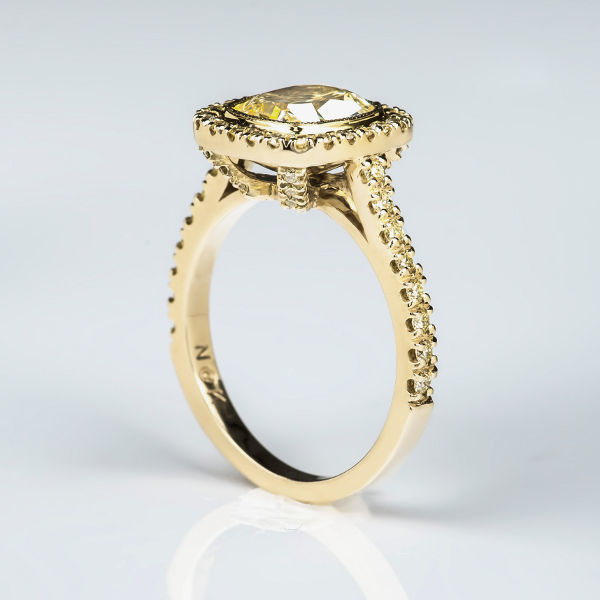 18 karat gold ring
18 karat gold ring
14K Gold: A Breakdown
14k gold isn’t as pure as 18k gold; it contains 58.3 percent gold, with 41.7 percent alloying material. It remains one of the most popular options for gold jewelry due to its ability to combine the advantages of pure gold and alloying metals together. In fact, more than 90 percent of all wedding and engagement rings in the United States are made from 14k gold.
Depending on what alloying materials are used, 14k gold usually retains the shiny yellow appearance associated with traditional gold - though it will be less intense than 18k gold. For some purchasers, this is actually an advantage; the saturated yellow color makes it ideal for some skin tones.
Let’s look at some of the advantages:
- Solid durability. 14k gold is quite strong compared to 18k gold or 24k gold. It’s much more resilient to scratches, though it can still be damaged if you’re not careful.
- A rich, gold-like appearance. You won’t get the vibrant shininess of 18k gold, but 14k gold still has a rich, gold appearance that can make any piece of jewelry beautiful.
- Relative inexpensiveness. 14k gold is one of the best options in terms of value. It’s inexpensive, but still carries many advantages.
So, are there disadvantages?
- Still more expensive than 10k gold. When comparing 10k gold with 14k gold, 14k gold is still somewhat expensive, making it less ideal for the budget-conscious consumer.
- Skin irritation possibilities. The high alloy content in 14k gold means there’s a possibility it could trigger skin irritation or an allergic reaction.
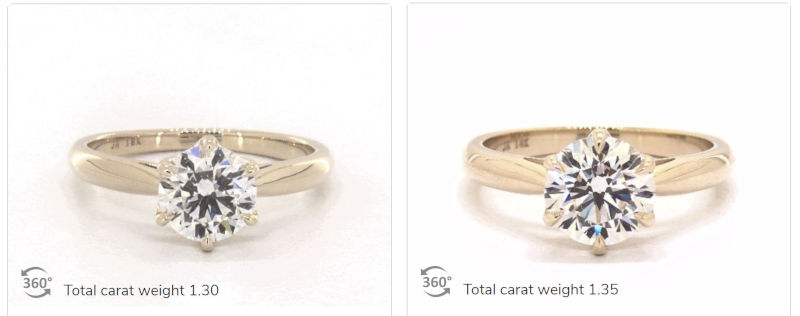 14k gold ring vs 18k gold ring, can you guess which karat is each of the rings?
14k gold ring vs 18k gold ring, can you guess which karat is each of the rings?
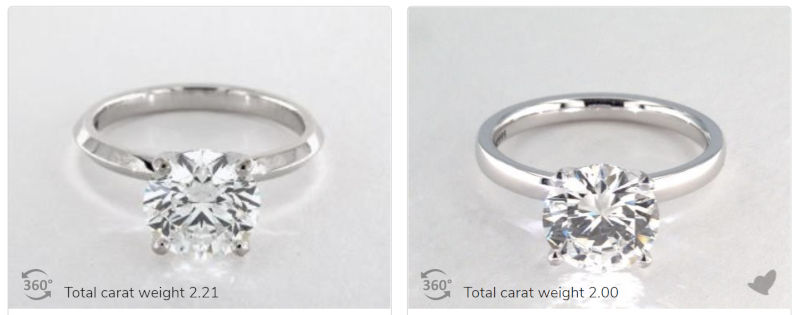 also in white gold - can you guess which is 14 karat gold and which ring is 18 karat gold?
also in white gold - can you guess which is 14 karat gold and which ring is 18 karat gold?
As you can see in the above examples from James Allen, 14k and 18k gold both commonly used both in white gold and in yellow. the preference is not only a matter of price. One of the above rings was sold for close to $40,000 yet it was still made of 14 karat gold.
10K Gold: A Breakdown
Now let’s look at 10k gold. This material is 41.7 percent gold, with 58.3 percent alloying metal. This is the least pure option that’s still commonly used in jewelry in the United States. In fact, this is the lowest purity of gold that can be legally marketed as “gold” in most countries.
This is a popular choice for many forms of gold jewelry, such as earrings, but it’s less common for engagement rings and other high-end pieces. Some jewelers don’t even offer 10k gold as an option because of this. 10k gold has a paler appearance than its 14k or 18k counterparts, but this isn’t necessarily a bad thing; some people actively prefer this softer, subtler tone.
There are some big advantages with 10k gold:
- Total inexpensiveness. 10k gold is the cheapest form of gold that’s still commonly used in jewelry. If you’re looking for the least expensive option, this is your best bet.
- Supreme toughness. Because of the high alloy content, most 10k gold rings don’t have the same vulnerabilities as their 18k counterparts. It’s much tougher to scratch or warp this type of material.
However, there are disadvantages as well:
- Pale coloration. While some may find it subtle and charming, most jewelry aficionados dislike the pale coloration of 10k gold.
- Higher likelihood of skin irritation. The high alloy content increases the likelihood of an allergic reaction - especially if the alloy used is nickel or zinc.
1K Gold: A Breakdown
Though rare, it’s possible to find some items sporting 1k gold, which is only 4.1667 percent gold by purity. This type of gold barely qualifies as “gold,” despite being marketed as such. It’s not recommended for any type of jewelry.
Note that there are also different karat ratings between the ones we’ve listed here, though they aren’t especially common.
Gold Alloys and Gold Colors (Yellow, White, and Rose)
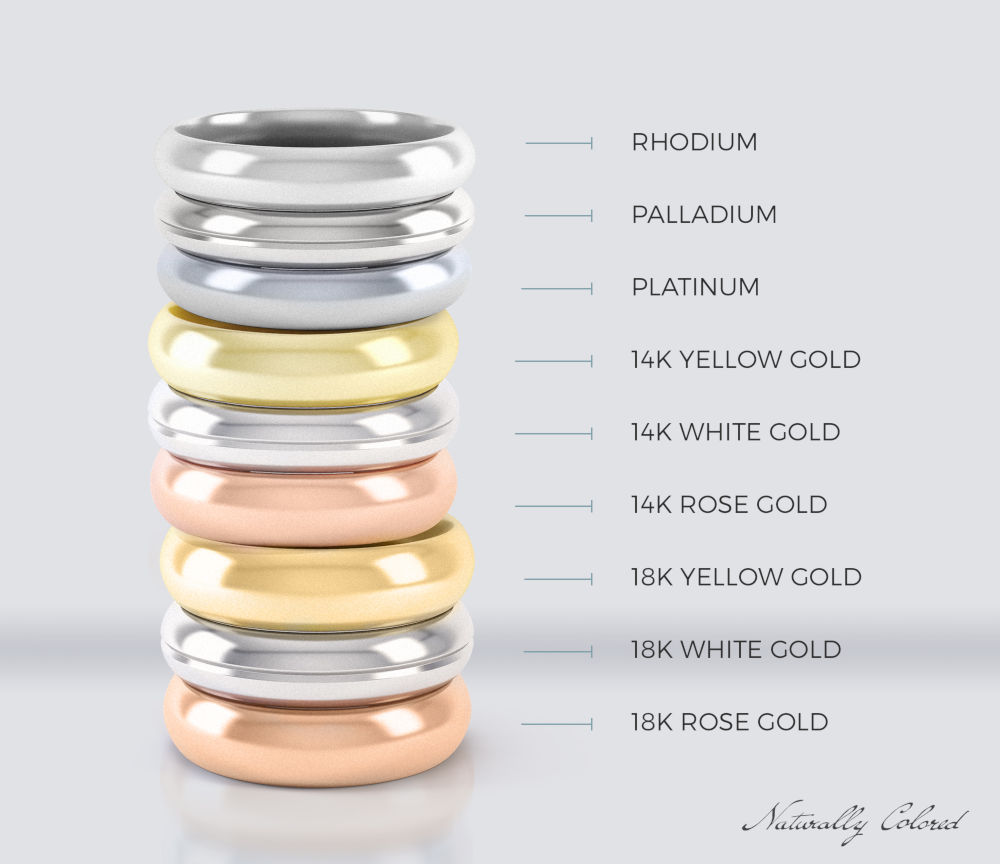 Illustration of wedding rings showing the differences between white, yellow and rose gold in different Karat scales
Illustration of wedding rings showing the differences between white, yellow and rose gold in different Karat scales
When choosing a gold ring, karats aren’t your only consideration. Much of your ring will likely be made of an alloying metal - and your choice of metal can make a big difference in how the ring ultimately looks and functions. Some of the most commonly used alloys in gold jewelry include silver, copper, zinc, nickel, palladium, and platinum.
There are four main ways the alloying metal affects the jewelry:
-
Coloration.
First, the alloying metal can change the color of the ring.
With purer gold jewelry pieces, this isn’t much of an issue; at 18k, most materials will still leave you with a bright, yellow, traditionally gold-looking ring.
But at 14k and especially 10k, you might end up with a different shade altogether.
If you include metals like palladium or platinum, you can end up with a paler finished product - often called “white gold” by jewelers.
If you include copper, you can tint the gold to look rosier, leading it to be called “rose gold.”
Color is an important considering factor. Someone who likes traditional jewelry might strongly prefer a bright yellow ring. Someone who wants something more romantic or unique-looking might prefer a rose gold ring. Someone with a fair or rosy skin tone might prefer white gold to complement their skin. - Durability. Different alloying metals offer different levels of strength. For example, platinum is one of the toughest options available. Alloying a ring with platinum can instantly make it more resistant to scratching and warping. Nickel can still confer some strength, but it isn’t on the same level.
- Skin sensitivity. You may also need to consider allergies and skin sensitivity. Nickel is one of the usual suspects in terms of triggering skin irritation; somewhere between 10 and 20 percent of the population experiences an allergic reaction in response to nickel. Zinc is also known as a common allergic trigger. However, platinum and palladium are often safe bets. Make sure you find out about a person’s potential allergic triggers before buying jewelry for them.
- Price. Finally, you’ll need to think about price. Some alloying metals are rarer and/or harder to work with than others, driving up the price. Copper, zinc, and nickel are all relatively inexpensive, driving down the price of the finished piece. By contrast, rings that contain silver, palladium, and/or platinum tend to be more expensive.
Determining Your Priorities - 24k gold? 18k gold? 14k gold? 10k gold?
So which type of gold should you choose for your jewelry?
That depends on your priorities. You’ll need to consider the importance of the following, at minimum:
- Appearance and color. One of your top considerations will likely be the appearance and the color of the ring. For the most part, this is subjective. A person’s skin tone, personal taste, and history with jewelry will often dictate their preferences. For example, bright yellow is preferred by people who like a traditional or classical look; it’s also preferred by people with darker skin tones. 18k gold is the top option here, or you could choose 14k gold with the right alloying metal. If you’re looking for white gold, you’ll need a lower karat rating and an alloying metal like palladium or platinum. And for rose gold, you’ll need a 14k or 10k ring with copper as an alloying material.
- Tactile feel and skin irritation. You’ll also need to consider how it feels to wear the ring and whether it’s capable of producing skin irritation. For millions of people, allergies stand in the way of enjoying certain types of metal. Gold itself isn’t usually a problem; no matter the purity of the gold you’re working with, the gold shouldn’t present an issue. Accordingly, higher purities are less likely to result in irritation. Issues arise with certain types of alloying metals. Zinc and nickel are the biggest culprits here, but you may also experience skin irritation issues with copper or silver. Palladium and platinum are the safest bets if you want to be sure, with the highest karat ring you can afford.
- Durability. Many people think that gold is incredibly durable, but in reality, it’s soft and easy to damage. This is why 24k gold jewelry options are hard to find; they would be ridiculously easy to scratch and warp. 18k gold may be beautiful and pure, but it’s also the most susceptible option to damage over time. Lower karat gold options offer more strength and durability. They become even stronger when they’re alloyed with metals that confer additional durability, such as platinum, though this may increase the cost.
- Expensiveness. Engagement rings, wedding rings, and other forms of high-end jewelry can be expensive. If you’re working with a tight budget, your options may be limited. 18k rings tend to be the most expensive options, with 10k being the most affordable option that’s still reasonable in terms of quality. 14k gold is often a good middle-of-the-road option in terms of price and value. You can also minimize expenses by choosing the right alloying metal to complement the gold.
- Pride. You may also choose jewelry out of pride. There’s something subjectively pleasing about picking out (and wearing) a ring with the highest purity of gold available. It has higher resale value, it looks more like “traditional” gold, and it gives you some bragging rights as well. That said, there are plenty of beautiful options at lower karat ratings as well – and they’re also more durable.
No matter what your priorities are, there’s a type of gold that’s right for you.
